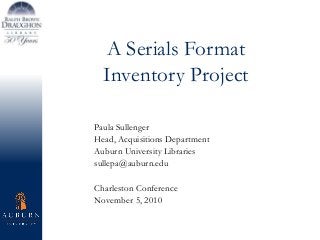
A Serials Format Inventory Project by Paula Sullenger, Auburn University
- 1. A Serials Format Inventory Project Paula Sullenger Head, Acquisitions Department Auburn University Libraries sullepa@auburn.edu Charleston Conference November 5, 2010
- 2. Auburn University - Comprehensive Land Grant University 25,000 students 12 schools/colleges Auburn University Libraries Ralph Brown Draughon (Main) Library of Architecture, Design, and Construction Cary Veterinary Medicine Library ARL since 1993 3 million+ volumes 2.5 million+ government documents 2.5 million+ microform
- 3. Electronic only at Auburn In 2004 and 2005, Auburn decided that electronic-only subscriptions are acceptable. By 2008, electronic only, with perpetual access, was preferred for several disciplines “Big Deal” packages from the major publishers One license, one registration process covers hundreds of titles Links easily established in OPAC, coverage dates same for all Different story for smaller publishers Still, publisher-by-publisher most efficient method since generally one license and one process will cover all a publisher’s titles
- 4. Inventory Project Goals: Change to electronic only where possible (Perpetual access is the main consideration) Expected to become a large % of our subscriptions Upgrade to print+electronic where electronic only is not an option Expected to remain a sizeable % of our subscriptions Find those titles which must remain print only Expected to be a small % of our subscriptions Identify access problems for titles already electronic
- 5. Serials Master List Used Ebsco’s “Online Availability” report as starting point For the project, created a smaller working list Sorted titles by publisher Eliminated Big Deal titles Working list of ~1,400 titles Would pick up non-Ebsco titles last (10%) Began late spring 2008 Hoped for a two-year project but needed three years to complete 5% serials cut for 2011 altered approach slightly Project completed late summer 2010
- 7. Electronic only subscriptions – Fewer than expected 4,844 paid subscriptions in 2008 1,852 already electronic only subscriptions in 2008 In 2008 identified 234 titles to change to electronic only for 2009 In 2009 identified 224 titles to change to electronic only for 2010 In 2010 identified 135 titles to change to electronic only for 2011
- 8. Print + electronic subscriptions – Fewer than expected No baseline count For 2011, will have 602 print + electronic 64 keep print per faculty request 310 have electronic only available but no perpetual access guarantee 19 have electronic only available but price is prohibitive 209 have no electronic only option
- 9. Print only subscriptions – Many more than expected No baseline count 1,323 print only for 2011 1,050 true print only* 162 have online available but on unacceptable terms email, password, one terminal, individual only 109 have electronic access available but price is prohibitive *Some of these titles are available electronically in aggregators but an electronic subscription is not available Examples: ABA Bank Marketing; ABA Banking Journal Journal of the Alabama Academy of Science 282 titles from original list canceled for 2011 190 others cancelled, ceased, now free online, etc.
- 10. Staffing/workflow implications Now have one full-time staff person dedicated to print serials functions for ~2,000 titles Will likely remain Holding one vacant staff position to determine if needed for electronic serials work Do we need one? Have accomplished all of this without an ERM Do we need one? Have ~600 print+electronic titles we want electronic only if circumstances change Review every year? Have ~1,300 print only titles How often to review these?
- 11. Where does Auburn stand? Elyse Profera & Christine Stamison, “An Agent’s Perspective on Issues and Best Practices When Shifting from Print to Electronic Resources.” Serials Review, 36:1 Mar 2010 p. 3-9 Swets analyzed purchasing trends for North American academic libraries 2008 – 34% electronic only (Auburn 38%) 30% print only 36% print + electronic 2009 – 40% electronic only (Auburn 56% in 2011) 29% print only (Auburn 30% in 2011) 31% print + electronic (Auburn 14% in 2011)
- 12. Chandra Prabha, “Shifting from Print to Electronic Journals in ARL University Libraries.” Serials Review 33:1 Mar 2007 p. 4-13 2006 – ARL Libraries had 36% electronic only Laura McElfresh, “Going E-Only: Coming Soon, the Deluge.” Technicalities 27:2 Mar/Apr 2007 p. 1, 11-14 2006 – Emory identified 600 titles to make electronic only Aparna Zambare, et al., “Assuring Access: One Library’s Journey from Print to Electronic Only.” Serials Review 35:2 June 2009 p.70-74 2008 – Central Michigan University had 53% electronic subscriptions, goal of 70% When can we really become electronic only?
